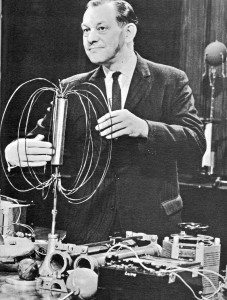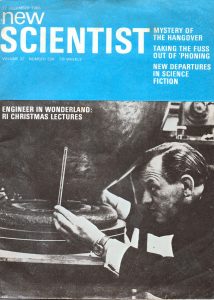
Eric Laithwaite was the first person to present the Royal Institution Christmas Lectures on television in 1966 on BBC2 (in black and white). The New Scientist photo below is the front cover from December 1966 previewing the forthcoming lecture series. That lecture series was called The Engineer in Wonderland. In my previous blog on Eric Laithwaite you will find references to both that lecture series and also the second series he was asked to give in 1974. I was present at some of the lectures in both of those years. Now, the Royal Institution has made available, via their web site, all (except lecture 6 “gyros” it seems) of the 1974 Christmas Lecture series The Engineer Through the Looking Glass. For those interested, it’s a treat to see him at his best, in front of a live audience! You will see below a list of the six lectures in that series.
 You may recall that there was some controversy over the content of lecture six where Eric Laithwaite demonstrated his theories of gyroscopes and how he thought he may have found that gyroscopes violated the law of conservation of energy. It appears that Laithwaite was waiting for the sixth and final lecture with something new and controversial, possibly breaking these laws of science. I have recently found the BBC archive pages of past editions of Radio Times. In them, I found the references and listing for the 1966 RI Christmas Lectures (The Engineer in Wonderland), the first to be televised and also given by Eric Laithwaite. The listing for the sixth and final lecture is interesting. Although I was actually present at that lecture I don’t remember the content, but the listing reference is very, very interesting it reads “Professor Laithwaite tries a completely new experiment which he hopes will break one of the laws of science. All the text books say it cannot be done. Will the experiment succeed?“. So, here we are again in 1974 with the sixth and final lecture (It’s my own invention) and once again Eric Laithwaite is trying something new, controversial and possibly breaking the laws of science in the process, is this a repeat of his idea from 1966? I must admit I hadn’t realised this until now! Maybe only he remembered the wording from that 1966 lecture? We’ll never know….
You may recall that there was some controversy over the content of lecture six where Eric Laithwaite demonstrated his theories of gyroscopes and how he thought he may have found that gyroscopes violated the law of conservation of energy. It appears that Laithwaite was waiting for the sixth and final lecture with something new and controversial, possibly breaking these laws of science. I have recently found the BBC archive pages of past editions of Radio Times. In them, I found the references and listing for the 1966 RI Christmas Lectures (The Engineer in Wonderland), the first to be televised and also given by Eric Laithwaite. The listing for the sixth and final lecture is interesting. Although I was actually present at that lecture I don’t remember the content, but the listing reference is very, very interesting it reads “Professor Laithwaite tries a completely new experiment which he hopes will break one of the laws of science. All the text books say it cannot be done. Will the experiment succeed?“. So, here we are again in 1974 with the sixth and final lecture (It’s my own invention) and once again Eric Laithwaite is trying something new, controversial and possibly breaking the laws of science in the process, is this a repeat of his idea from 1966? I must admit I hadn’t realised this until now! Maybe only he remembered the wording from that 1966 lecture? We’ll never know….
Lecture 1
LOOKING GLASS HOUSE
Lecture 2
TWEEDLEDUM AND TWEEDLEDEE
Lecture 3
JAM YESTERDAY, JAM TOMORROW
Lecture 4
THE JABBERWOCK
Lecture 5
THE TIME HAS COME THE WALRUS SAID
Lecture 6
ITS MY OWN INVENTION
Colin Grimshaw January 2014 (revised December 2022)
Hi Colin!
You may remember me from my time in Stoic until 2005. I’ve been trying to get in touch with you but I can’t find a contact so I’m leaving a comment here in the hope that you will be able to send me a message.
I hope all is well and I really like what you’re doing with this blog!
Happy New Year,
Andy Bennett.
Hi Andy,
Yes I do indeed remember you from the “good old days” at Imperial. I am still on the Imperial email system if you search that, but I’ll also send you a direct email anyway. We can’t publish email addresses on blogs because the internet crawlers pick them up and spam us more that they do at present!
Colin Grimshaw
Eric Laithwaite Xmas lectures:
” is this a repeat of his idea from 1966? I must admit I hadn’t realised this until now!….. We’ll never know….”
Yes we will know!
Eric Laithwaite published books about both of his Xmas lectures “The Engineer in Wonderland” and “Engineer Through The Looking Glass”. The titles of the books being the same.
I have both these books, and the final lecture in the 1966 lectures was not about gyroscopes. It was a Floating Ball experiment. He was going to attempt to levitate a giant sphere above a series of coils. He had done it on a small scale but he genuinely did not know what would happen when scaled up. Would it shoot up in the air? Would it shoot off to the side? Would it start to spin, and if so how fast and in which axis. If it started to spin violently they would be in big trouble, and possibly wouldn’t be able to get it down again safely without evacuating the building!
The book goes into this experiment in great detail (including photos) and the problems they had in choosing the coils, connections, voltages and currents, etc. and getting the sphere manufactured in time for the last lecture. There was only a limited power supply available at 200 amps or so, and they had no continuous control of the voltages. Apparently, the experiment also featured in The New Scientist at the time, which you might be able to trace.
Anyway, I am sorry if you already know all this. Eric Laithwaite was an absolute genius in the way he entertained and educated his audience. His lectures were genuinely exciting and not just a recitation of facts from a text book. Do you know if his 1966 lectures still exist at the BBC? It would be a tragedy if these have been wiped, but it wouldn’t surprise me. Next month is their 50th anniversary.
Thank you for listening.
Melvyn.
The quote about a ‘repeat’ was from the 1966 Radio Times and the point I was making was that he was once more trying something new and maybe ‘breaking the laws of science’ when trying to float the large ball. He also tried this is the last lecture in 1974 with the gyros. I was at that 1966 last lecture and can confirm that he held back from trying the experiment until the time of the lecture.
I also have the three books and the New Scientist edition from that December 1966 and recall their visit to the lab and photographer taking photos.